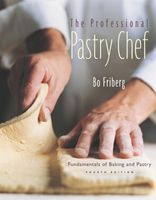Advertisement
Filling and Piping with a Pastry Bag
Appears in
By Bo Friberg
Published 1989
Use a pastry bag that is large enough to allow you to fill the bag only half to two-thirds full. This will prevent the contents from being forced out through both ends.
- Cut the opening of a new bag so that the point of your largest piping tip just barely shows through; this ensures that the opening will not be too large for the smaller tips.
- Fold open the top half or third of the empty bag.
- Place the tip in the bag. Turn the bag upside down and force a small part of it, closest to the tip, inside the tip to lock the bag and prevent the filling from running out (Figure 1-11). This is a good habit all of the time but essential when you are piping a thin or runny filling.
- Use one hand to hold the bag under the folded section and place the filling in the bag with the other (Figure 1-12).
- Straighten out the fold and slide the top of the bag between your thumb and forefinger from the top to where the filling is, on both sides of the bag, to move the filling away from the top and remove any air pockets. Twist the bag closed at the top. Turn the bag upside down and pull the tip up to release the inverted (locked) bag. Twist to temporarily relock it before pointing the bag down to pipe (Figure 1-13).
- Hold the bag by resting the top between your thumb and fingers and apply pressure to the top of the bag with the palm of your hand only. Use your other hand to guide the tip or to hold onto the item being filled or decorated; do not apply pressure with this hand.
Squeeze some of the filling back into the bowl to make sure there are no air pockets near the tip before piping on the item you are decorating. When you are ready to pipe, untwist to open the flow, then twist again as you move between items so that the filling does not continue to run out (Figure 1-14). This is not necessary with a thick filling, such as cookie dough, that will stay in the bag without running.

